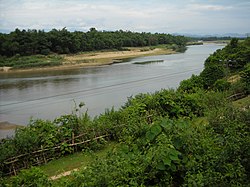Top Qs
Timeline
Chat
Perspective
Hà Tĩnh province
Province of Vietnam From Wikipedia, the free encyclopedia
Remove ads
Hà Tĩnh is a northern coastal province in the North Central Coast region, the Central of Vietnam. It borders Nghệ An to the north, Quảng Bình to the south, Bolikhamsai and Khammouane of Laos to the west and the South China Sea (Gulf of Tonkin) to the east.
Hà Tĩnh together with neighbouring Nghệ An province the two provinces are together called "Nghệ Tĩnh", and the locals are known for speaking Vietnamese with a very noticeable regional accent.[5][6]
Remove ads
Geography
Hà Tĩnh is about 340 km (211 miles) south of Hanoi.
Climate
The climate is sub-tropical, with cooler temperatures in winter; Vietnam's highest ever temperature, 43.4 degrees Celsius (110 Fahrenheit), was recorded in the province in 2019.[7]
Administrative divisions

Hà Tĩnh is subdivided into 13 district-level sub-divisions:
- 10 districts:
- 2 district-level towns:
- 1 provincial city:
- Hà Tĩnh (capital)
They are further subdivided into 12 commune-level towns (or townlets), 235 communes, and 15 wards.
Tourism and notables
Hà Tĩnh has many locations of historical and cultural interest that are popular with tourists. It is home to national figures such as Lê Hữu Trác, Nguyễn Du (the author of the epic poem Kim Vân Kiều), Nguyễn Công Trứ, Phan Đình Phùng, Trần Phú, Ngô Đức Kế, Nguyễn Phan Chánh, Hoàng Ngọc Phách, Xuân Diệu, Huy Cận, Hoàng Xuân Hãn, Nguyễn Khắc Viện, Lê Văn Thiêm, Điềm Phùng Thị and Nguyen Do. Notable scenic areas include La River, Vũ Môn Falls, Vũ Quang Garden, Kẻ Gỗ Lake, Sơn Kim hot springs, Đèo Ngang pass, Hương Tích Pagoda, and beaches in places such as Thiên Cầm, Ðèo Con, Xuân Thành and Chân Tiên. Most of them are along Highways 1A and 8.
Remove ads
Transport
Hà Tĩnh has 130 km (82 miles) of Highway 1A stretching from Bến Thủy Bridge (Vinh City) to Đèo Ngang Pass linking Hà Tĩnh and Quảng Bình. The Ho Chi Minh Route is the second most important route of the province. Hà Tĩnh also contains Road 8 which runs from Hồng Lĩnh town to Laos and the Viet-Lao highway from Vũng Áng Harbour (Kỳ Anh District) to Laos. In 2007, a railway link to Laos was proposed from Hà Tĩnh province. Air transport is served by Vinh International Airport in nearby province of Nghệ An.
Remove ads
Economy
Agriculture, forestry and fishery takes up 35.5 percent of total GDP and the province's GDP accounts for 0.7 percent of Vietnam's GDP. Hà Tĩnh has taken slow steps in economic reforms though better signs in recent times are incentive. Vũng Áng harbour with some plants, factories and a thermal power station is becoming the most active economic hub. Vietnam Steel operates an iron mine in Thạch Khê District,[8] with reserves of 544 million tonnes of iron, which is one of the largest mines in southeast Asia.[9]
A US$10 billion iron and steel plant was built in Vũng Áng in the 2010s (see Formosa Ha Tinh Steel Corporation). The steel plant is part of an industrial park, which is estimated to cost more than US$20 billion. When finished in 2020, the industrial park will have a port, a 2,100-MW power plant and a steel plant with six blast furnaces.[10] In 2016, the Formosa Steel plant released untreated waste water with heavy metals and other toxins into the nearby sea, which caused the 2016 Vietnam marine life disaster.[11]
Remove ads
History


In chữ Hán, the province's name is written as 河靜, meaning "quiet river". Beginning in 1930 Hà Tĩnh, along with Nghệ An and Quảng Ngãi, was one of the early grounds for the Vietnamese rural Soviet movement and protests.[12][13]
References
External links
Wikiwand - on
Seamless Wikipedia browsing. On steroids.
Remove ads











